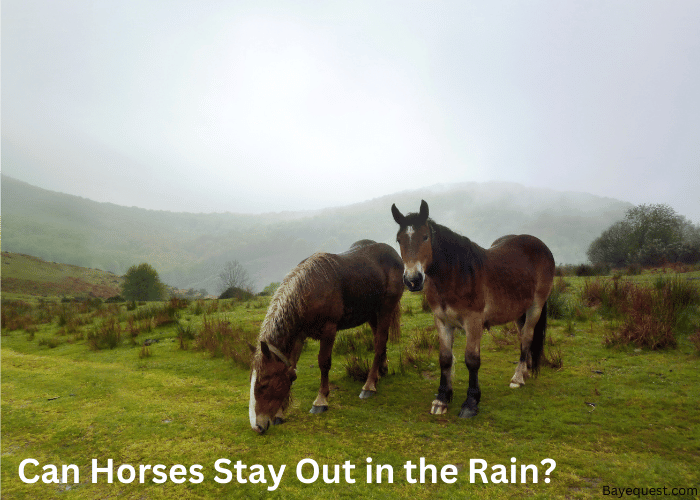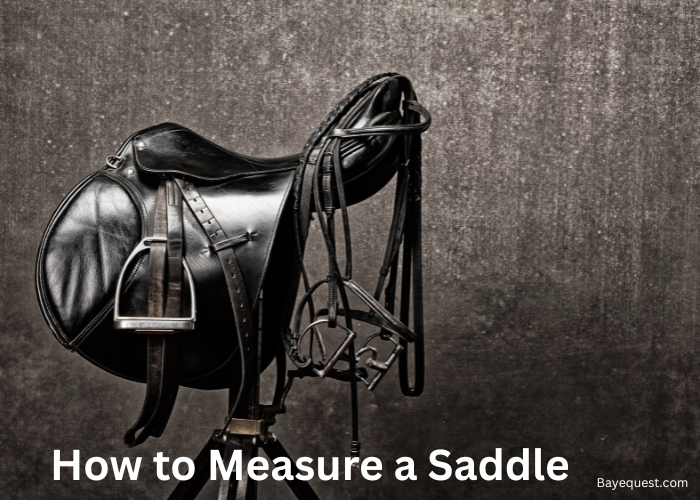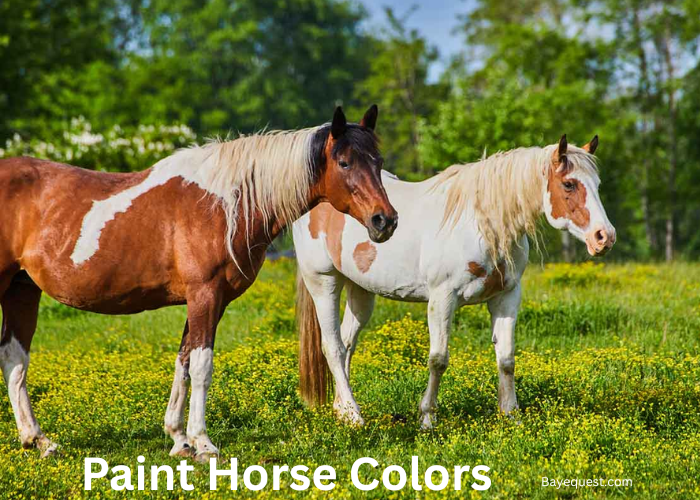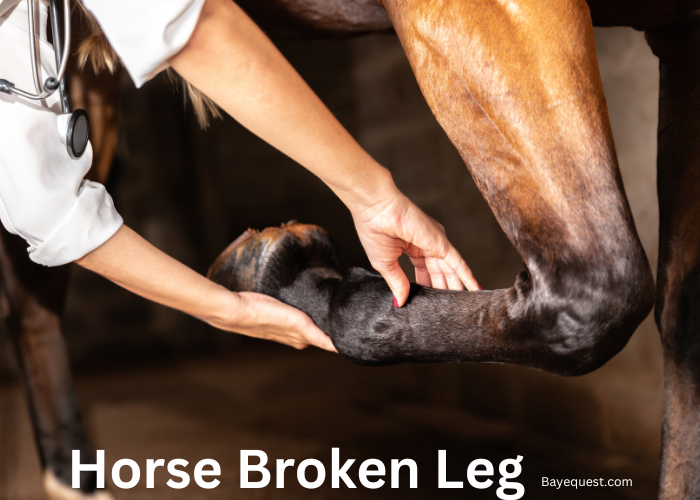Rain is falling, and your horse is out there, tail swishing and ears flicking. You wonder, should you bring them in or let them be?
Horses have lived through rain, sleet, and snow for centuries. Their coats are made to repel water, and they don’t mind a little shower.
But when does rain cross the line from refreshing to risky? And how do you know if your horse is enjoying the weather or just plain miserable?
Let’s dive into what’s best for your four-legged friend when the skies open up.
Can Horses Stay Out in the Rain? Key Takeaway
Yes, horses can stay out in the rain if it’s light and not too cold. Their coats are naturally water-resistant. However, in heavy rain or cold wind, they need shelter to avoid health risks like hypothermia or skin infections. Always check your horse and provide dry areas when the weather gets harsh.
Natural Adaptability of Horses to Rain
Horses are built to handle rain naturally. Their coats have two layers.
The outer layer has long, coarse hairs. These hairs are water-repellent. When it rains, water slides off this layer, keeping the horse dry underneath.
The inner layer is made of soft, fluffy hairs. This layer traps heat and keeps the horse warm, even when it’s wet outside.
Horses also produce natural oils from their skin. These oils spread through their coat and help repel water.
You might notice their coat looking shiny; that’s the oil at work. Additionally, horses can fluff up their inner coat. This creates an extra layer of insulation, like a warm blanket.
A horse’s body also regulates its temperature well. It can adjust blood flow to the skin to keep warm or cool down.
However, this natural adaptability works best in mild rain. Long, cold, and windy rain can be a challenge.
How Long Can Horses Stay Out in the Rain?
Horses can stay out in the rain for 4-6 hours if the conditions are mild. Their natural coat and body mechanisms help them stay dry and warm during short periods of rain.
Light rain or drizzle is usually not a problem for a healthy horse. They can comfortably graze and move around without much stress.
However, if the rain is heavy, cold, or combined with strong winds, it becomes risky. Prolonged exposure to such conditions can lead to issues like hypothermia, mud fever, or rain rot.
Horses may become uncomfortable, especially if they are wet to the skin and cannot dry off.
Young, elderly, or sick horses may also need protection sooner. In these cases, provide a shelter, like a run-in shed.
Benefits of Allowing Horses to Stay Out in the Rain
Allowing horses to stay out in the rain can have several benefits when the conditions are safe and controlled. These include:
Strengthens the immune system. Exposure to natural elements like rain helps horses build a stronger immune system. It makes them more resilient to changes in weather and reduces the chances of getting sick when exposed to mild cold or dampness.
Improves mental health. Horses are naturally outdoor animals. Staying outside, even in the rain, provides mental stimulation and prevents boredom. It helps maintain their natural behaviors, like grazing and moving around.
Promotes hoof health. Moisture from rain can benefit a horse’s hooves by keeping them hydrated. Dry conditions can cause cracks or brittle hooves, while natural moisture from rain helps keep hooves strong and healthy.
Encourages natural behavior. Being outside allows horses to express natural behaviors, such as grazing, socializing, and moving freely. This freedom is crucial for their physical and psychological well-being.
Regulates body temperature. Rain helps cool horses down in warmer weather, preventing overheating. Their bodies can adapt to temperature changes, keeping them comfortable in varying conditions.
When Does Rain Become a Concern for Horses?
Rain becomes a problem when it’s more than a light shower. Cold rain mixed with wind can make a horse shiver and lose body heat fast.
If it rains for hours and the temperature drops, a horse can get chilled. When rain soaks through their coat and gets to the skin, they can’t stay warm. That’s when hypothermia can set in.
Heavy rain also turns the ground to mud. Mud can lead to issues like mud fever, a painful skin infection on their legs.
If a horse stands in wet, muddy conditions too long, it can also cause hoof problems like thrush.
Thunderstorms bring more dangers—lightning and high winds can spook a horse or cause serious harm.
When rain turns harsh or lasts too long, horses need a place to get dry and warm. It’s not just about rain; it’s about how cold, windy, and wet it gets.
Rain Related Health Concerns for Horses
Rain can bring several health concerns for horses, especially when they’re exposed for too long. These health concern include:
Hypothermia. When a horse gets soaked to the skin in cold, windy rain, it can lose body heat quickly. This can lead to hypothermia, which is dangerous.
Rain rot. Also known as “rain scald,” this skin infection happens when horses stay wet for long periods. Bacteria thrive in moist conditions, causing scabs and hair loss on a horse’s back and sides. It can be itchy and painful.
Mud fever. When the ground turns to mud, it can lead to mud fever, especially on a horse’s lower legs. Mud fever is a bacterial infection that causes swelling, sores, and scabs. It can be painful and may lead to lameness if untreated.
Thrush. Horses standing in wet, muddy areas for too long can develop thrush in their hooves. Thrush is a bacterial infection that affects the frog of the hoof. It creates a foul smell and can cause discomfort or lameness.
Respiratory issues. Damp, cold conditions can also lead to respiratory problems. Wet, chilly weather can make it harder for them to breathe or worsen conditions like heaves.
How to Provide Shelter and Protection to Horses
You can provide shelter and protection to horses through the following ways:
Run-in sheds. These are three-sided shelters where horses can enter and leave as they like. They offer a quick escape from rain, wind, and sun. Make sure the shed faces away from the wind and has good drainage to keep the floor dry.
Barns and stables. In heavy rain or storms, bringing horses into a barn or stable is best. It keeps them warm, dry, and safe. Ensure good ventilation to prevent breathing issues and keep bedding clean to avoid wet spots.
Tree cover and natural shelters. Dense tree lines or wooded areas can provide some natural protection against light rain and wind. However, don’t rely on them during severe weather, as falling branches can be dangerous.
Waterproof blankets. Use waterproof blankets for added protection. Ensure they fit well and don’t trap moisture underneath. Not all horses need blankets, but older or weaker ones might benefit.
Drainage and mud control. Keep areas around shelters dry by managing drainage. Proper drainage prevents mud, reducing the risk of mud fever and hoof problems.
Routine checks. Regularly check on your horses during bad weather. Ensure they’re dry, warm, and not showing signs of discomfort or illness.
Post Rain Care for Your Horse
After the rain stops, your job isn’t done. Your horse needs some care to stay healthy.
Checking them over. Look for any signs of shivering or discomfort. Feel their coat—if it’s soaked to the skin, they might need to dry off.
Use a towel or scraper to get rid of excess water. This helps them dry faster.
If it’s cold, cover them with a dry, breathable blanket. But don’t leave a wet blanket on; it will make things worse.
Next, check their legs and hooves. Mud can cause issues like mud fever or thrush.
Clean off any mud and make sure their hooves are picked out and dry. A quick grooming session can help remove dirt and loosen any tangles in their mane and tail.
Also, take a moment to check for any cuts, scrapes, or signs of rain rot. Early detection can prevent bigger problems. Fresh water and good feed can help them recover energy after being out in the rain.
How to Manage a Horse’s Coat and Health in Rainy Weather
Keeping a horse healthy in rainy weather starts with their coat.
A horse’s coat has natural oils that repel water. Regular grooming helps spread these oils and keeps the coat working right.
To clean off dirt and dust, use a soft brush. It keeps the coat shiny and water-resistant.
If your horse gets soaked, make sure they dry off well. You can use a towel or a sweat scraper to remove excess water.
In cold weather, a waterproof blanket can help, but only if it’s dry and fits well. A wet blanket will only make things worse.
Check their skin often, especially on the back and legs. Rain can lead to skin issues like rain rot or mud fever.
Catching these early can save a lot of trouble. Keep an eye on their hooves too.
Wet and muddy conditions can cause problems like thrush. Pick out the hooves regularly and keep them dry when possible.
Good feed and fresh water are also important. A healthy diet supports a strong immune system.
With a bit of care, your horse can handle rainy weather without a hitch.
How Rain Affects Saddles, Blankets, and Other Equipment
Rain can be tough on saddles, blankets, and other horse gear.
Leather saddles are the most affected. When leather gets wet, it can dry out, crack, or get stiff.
If you ride in the rain, make sure to clean and condition the saddle afterward. This keeps the leather soft and prevents damage.
Synthetic saddles handle rain better but still need care. Water can seep into seams or padding, causing mold or mildew.
Always let them dry well after getting wet. Never store wet gear in a tack room; it invites mold.
Blankets are another concern. If a blanket gets soaked, it can become heavy and uncomfortable for the horse.
Worse, a wet blanket loses its insulating ability and can chill the horse instead of keeping it warm. Make sure blankets are waterproof and check them often.
Remove wet ones right away and replace them with dry ones. (Also, check out our guide on How to Clean Horse Blankets.)
Reins, stirrup leathers, and other straps can also be affected. Wet conditions weaken them over time.
Check them regularly for signs of wear and tear. A little care goes a long way in keeping your tack in good shape and ready for the next ride.
Can Horses Stay Out in the Rain? Conclusion
So, can horses stay out in the rain? Sure, they can, but it’s all about balance.
A drizzle? No big deal. They’ll shake it off and keep grazing.
A cold, windy downpour? That’s when they need a little help.
Horses are tough, but they still need some TLC when the weather turns wild. Keep an eye on them, keep them comfy, and they’ll be ready to face the next rainy day with a flick of the tail and a happy snort.








